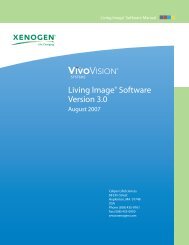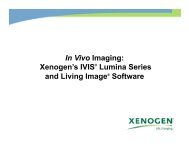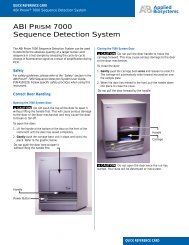ABI PRISM 7000 Sequence Detection Systems Relative ...
ABI PRISM 7000 Sequence Detection Systems Relative ...
ABI PRISM 7000 Sequence Detection Systems Relative ...
Create successful ePaper yourself
Turn your PDF publications into a flip-book with our unique Google optimized e-Paper software.
Primer Extended on mRNA<br />
5′ 3′<br />
5′ cDNA<br />
Reverse<br />
Primer<br />
Oligo d(T) or random hexamer<br />
Synthesis of 1st cDNA strand<br />
3′ 5′ cDNA<br />
Designing an RQ Experiment<br />
Workflow<br />
Designing<br />
an RQ<br />
Experiment<br />
Performing<br />
Reverse<br />
Transcription<br />
Generating<br />
Data from<br />
RQ Plates<br />
Designing an RQ Experiment<br />
• Select the PCR method<br />
(multiplex or singleplex).<br />
• Designate the targets, calibrator,<br />
endogenous control, and replicates.<br />
• Select the SDS chemistry and<br />
reagent configuration.<br />
• Choose the primers and probes.<br />
2<br />
Performing<br />
an RQ Study<br />
Selecting the PCR Method<br />
DRAFT<br />
September 26, 2003 3:14 pm, C2_Design.fm<br />
Traditional PCR is performed as a singleplex reaction, where a single primer pair is<br />
present in the reaction tube or well. Only one target sequence or endogenous control can<br />
be amplified per reaction—target sequences and endogenous controls cannot be<br />
amplified in the same tube.<br />
In multiplex PCR, two or more primer pairs are present in the reaction. Each primer pair<br />
amplifies either a target sequence or an endogenous control. The availability of multiple<br />
reporter dyes for TaqMan ® probes, each with different emission wavelength maxima,<br />
makes multiplex PCR possible.<br />
Notes<br />
<strong>Relative</strong> Quantification Getting Started Guide for <strong>7000</strong> v1.1 7










